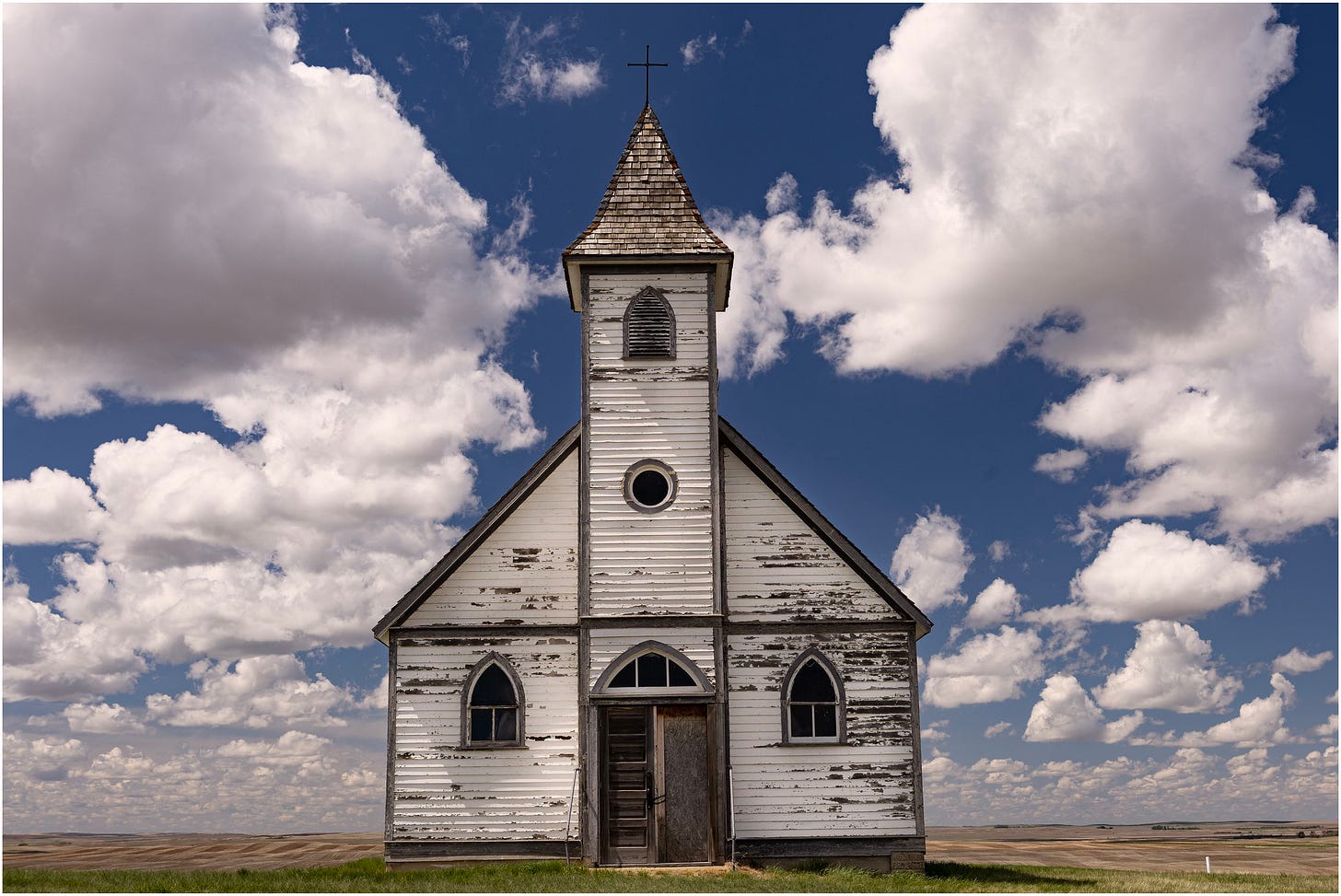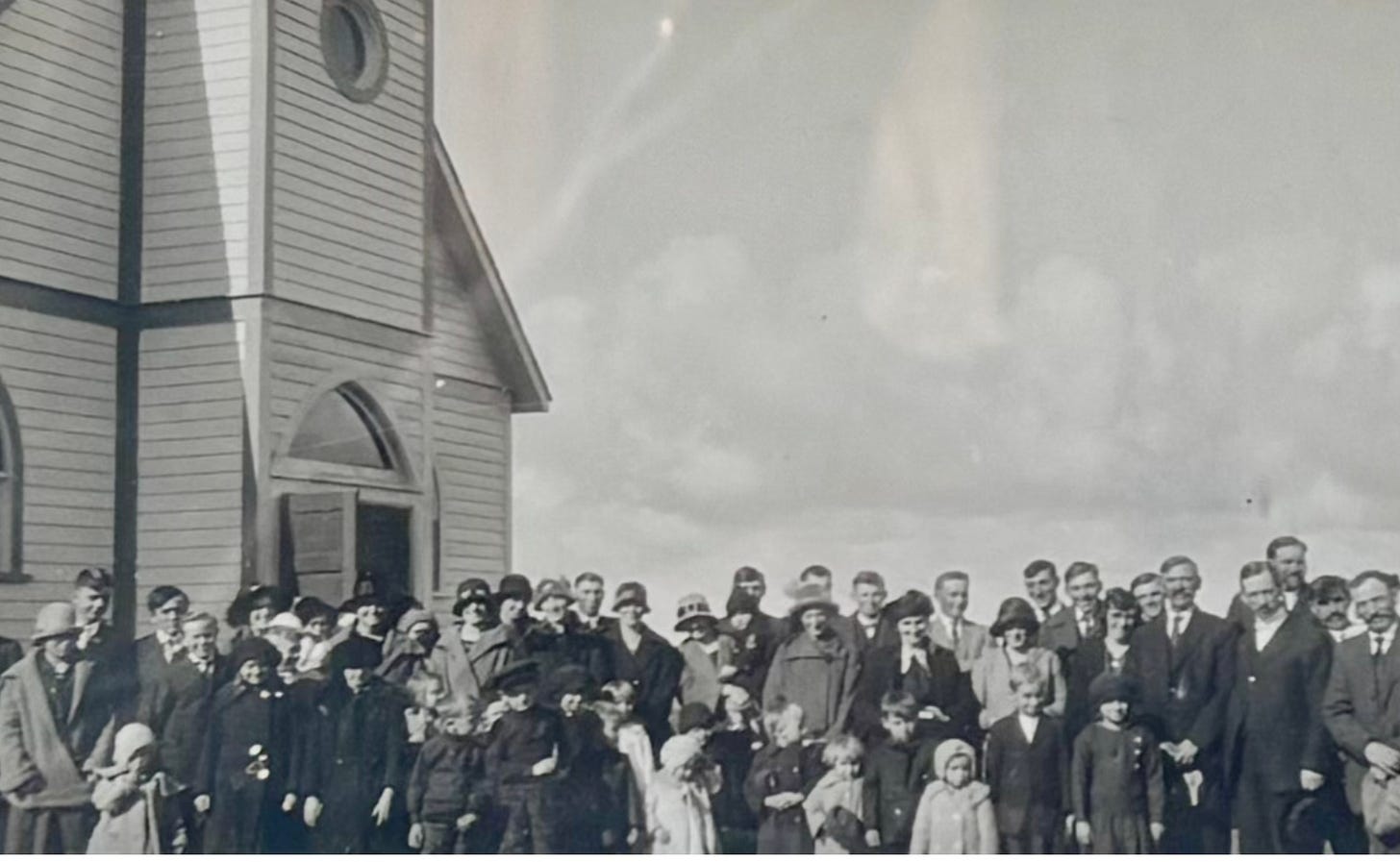Echoes of an Era/Echi di un’era
A forgotten church tells the story of rural Canada’s multicultural roots/Una chiesa abbandonata racconta le radici multiculturali del Canada rurale (testo in italiano segue quello in inglese)

As Italians, it usually takes a church at least as old as the Baroque or Renaissance period to make us change course during a road trip. But that little chapel, standing solitary and forlorn beneath one of Saskatchewan’s “living skies,” seemed to be calling us. As if it had a story to tell. And so it did.
When we reached it—turning off Highway 13 and onto a dirt road, made slick from a recent downpour—we discovered it was the Peace Lutheran Church of Stonehenge, SK, not far from the town of Assiniboia. The building was clearly abandoned, and yet it radiated a peculiar energy. Or perhaps it was just the effect of the midday light, piercing and surreal, and of the clouds, hovering between earth and sky like glowing hot-air balloons.
Time Suspended Inside
As we approached the entrance, we noticed it was secured only by a simple hook. So we went in. Inside, time felt frozen. Everything was still in its place: the wooden pulpit, the rows of humble, dust-covered chairs, the tiny stained-glass windows filtering in light with modest grace. Those chairs still seemed to be waiting for a congregation that would never return.
Outside, a commemorative plaque honours the twelve families of pioneers from Germany and Romania who settled in this land around 1911 and, through collective effort, built this place of worship in 1925.

Voices from the Cemetery
But the most moving testimony lies in the tiny cemetery, half-hidden among the tall prairie grasses not far from the church. All the graves, save one, belong to members of the Silzer family.
A quick look through Canada’s census archives reveals that the patriarchs of the Canadian branch, John G. Silzer (1864-1938) and his wife Amalia Tobias Silzer (1864-1946), were born in Romania, in a German-speaking Lutheran community.

Like many families of their time, they helped cultivate and develop the agricultural life of the region. One of their grandsons, Jacob Silzer, served in World War II and later rose to the rank of Chief Warrant Officer in the Canadian military. He died in Kingston, Ontario, in 2004. The household also included two young farmhands—one from Germany and one of Romani descent—as well as a domestic worker from Russia.
This simple yet eloquent human microcosm reflects the multicultural fabric of Saskatchewan’s early farming settlements: even then, between furrows and Sunday sermons, stories, languages, and hopes from rural Europe were taking root across the vast Canadian prairies.
A short video capturing the Peace Lutheran Church and its prairie surroundings, as Stefano steps inside the building (video: Arianna Dagnino) .
Echi di un’era
Da italiani, difficilmente una chiesa che non sia almeno dell’epoca barocca o rinascimentale riesce a catturare la nostra attenzione e farci cambiare itinerario durante un viaggio on the road. Ma quella chiesetta che si stagliava solitaria e desolata contro uno dei “cieli viventi” del Saskatchewan sembrava chiamarci. Come se avesse una storia da raccontare. E così era.

Quando l’abbiamo raggiunta, lasciando la Highway 13 e imboccando una strada sterrata resa particolarmente scivolosa dopo uno scroscio di pioggia, abbiamo scoperto che si trattava della Peace Lutheran Church di Stonehenge, SK non lontano dalla cittadina di Assiniboia (2389 abitanti). L’edificio era visibilmente abbandonato, eppure sprigionava una strana energia. O forse era tutta suggestione, dovuta alla luce meridiana di un’intensità vertiginosa e a quelle nuvole che sembravano sospese tra terra e cielo, come mongolfiere lucenti.

Dentro il tempo sospeso
Avvicinandoci alla porta d’ingresso, ci siamo accorti che era chiusa solo da un semplice gancio. Così siamo entrati. Il tempo, lì dentro, sembrava essersi fermato. Tutto era ancora al suo posto: il pulpito di legno, le file di modeste sedie impolverate, le minuscole vetrate che filtravano la luce con grazia dimessa. Quelle sedie parevano ancora in attesa di una congregazione che non sarebbe mai più tornata.

All’esterno, una lapide commemorativa ricorda le dodici famiglie di pionieri provenienti dalla Germania e dalla Romania che si insediarono in queste terre intorno al 1911 e che, nel 1925, con uno sforzo collettivo, eressero questo luogo di culto.
Voci dal cimitero
Ma la testimonianza più toccante arriva dal minuscolo cimitero seminascosto tra le erbe alte della prateria sconfinata, non lontano dalla chiesa. Tutte le tombe, tranne una, appartengono a membri della famiglia Silzer.

Una rapida ricerca presso gli archivi del Canada Census rivela che i capostipiti del ramo canadese, John G. Silzer (1864-1938) e sua moglie Amalia Tobias Silzer (1864-1946), erano nati in Romania, all’interno di una comunità luterana di lingua tedesca. Come altre famiglie dell’epoca, contribuirono allo sviluppo agricolo della zona. Uno dei loro nipoti, Jacob Silzer, prestò servizio durante la Seconda guerra mondiale e in seguito divenne Chief Warrant Officer nelle forze armate canadesi. È morto nel 2004 a Kingston, in Ontario. Nello stesso nucleo domestico vivevano anche due giovani braccianti, uno proveniente dalla Germania e uno di etnia rom, oltre a una domestica originaria della Russia.
Questo semplice ma eloquente microcosmo umano riflette il tessuto multiculturale delle prime comunità agricole del Saskatchewan: già allora, tra solchi e messe domenicali, si intrecciavano storie, lingue e speranze di un’Europa rurale trapiantata nelle vaste praterie canadesi.
Un breve video che ritrae la Peace Lutheran Church e il paesaggio circostante della prateria, mentre Stefano entra nell’edificio (video: Arianna Dagnino).
Feel free to share the link to this newsletter! Condividi il link a questa newsletter!






That place...that sky...the breeze in the cemetery: everything in this article evokes a wondrous sense of suspended animation. Thanks for stopping there and sharing this.
Great piece!